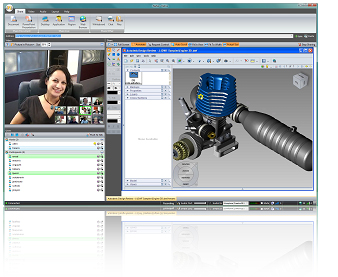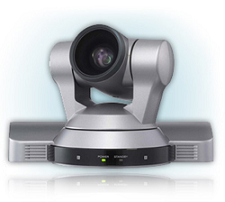
HP Halo Collaboration Studio v.
Video Conferencing Using Industry Standards
Nefsis Commentary — July, 2006 — The following commentary is provided by Nefsis regarding general media coverage of
Hewlett-Packard Halo Collaboration Studio, Halo Video Exchange Network (HVEN), and its application in corporate
and government networks.
Alternatives to HP Halo Telepresence
Founded in 1998, WiredRed Corporation / Nefsis is a technology leader in the real-time communications. The company
specializes in multi-office communications over existing networks, with more than 4,000 corporate, government and educational
customers worldwide.
Until recently, real-time communications has enjoyed a behind-the-scenes profile. It was the domain of government,
financial services and healthcare concerns that needed to communicate complex topics quickly across distributed teams,
but without creating serious network security violations. Boardroom video conferencing systems from Polycom and
Tandberg enjoyed a substantial installed base; while secure messaging and rich media conferencing systems from Nefsis,
among others, enjoyed a growing market, even during the IT budget freeze of recent years. Not until recently has the public
and the general business media been interested in topics such as HD video conferencing for business and telepresence.
 Today,
real-time communications has taken center-stage.
Web conferencing, once used only in sales and marketing for web seminars, is now being employed in work-a-day meetings.
Internet connections are prevalent, and Logitech has shipped over 25 million webcams. Digital video is everywhere and growing.
And to the delight of the industry at large, Hewlett Packard has jumped into the video conferencing game promoting their
$500,000 Halo Collaboration Studio. The HP name has drawn the attention of the general media in a way the entire real-time
vendor communityhas never done before. This publicity is a wonderful thing.
Today,
real-time communications has taken center-stage.
Web conferencing, once used only in sales and marketing for web seminars, is now being employed in work-a-day meetings.
Internet connections are prevalent, and Logitech has shipped over 25 million webcams. Digital video is everywhere and growing.
And to the delight of the industry at large, Hewlett Packard has jumped into the video conferencing game promoting their
$500,000 Halo Collaboration Studio. The HP name has drawn the attention of the general media in a way the entire real-time
vendor communityhas never done before. This publicity is a wonderful thing.
Why the Sudden Interest in HP Halo Collaboration Studio?
The reasons are simple. The market drivers for video conferencing have never been stronger: travel restrictions and
new
green
computing policies. In addition, traditional video conferencing has a history of being unreliable and hard to use.
For a monthly fee, Halo provides a concierge service that manages each meeting from call set-up to tear down.
There is another reason too. The general business press does not know what the information technology media and real-time
vendors have known for years. Namely, that full-screen video conferencing is easily possible, routes over the Internet, and
does not have to cost hundreds of thousands of dollars.
Other Comments Regarding HP Halo Collaboration Suite
So the time was ripe for a fresh look at video conferencing, and the timing of HP's product roll-out was fortuitous.
But let's face it, every editor worth his or her salt has done some business travel, and seen trophy boardroom video conferencing
equipment collecting dust. So it's no surprise that many editors include both favorable and critical comments in their HP Halo
coverage. They know their audience has heard of video conferencing.
The critical commentary surrounding Halo has often focused on price. Each video conferencing room (called a "studio"
in HP parlance) costs approximately $300,000. Two are needed, plus $18,000 per month in bandwidth and concierge service. For example,
in a recent interview a noted industry analyst says "... is a ridiculous price, and I'm just really surprised that a company
as technically savvy as HP would come out with a system like this." [San Diego Union, page B-1, April 7, 2006].
HP Halo Rooms v. Traditional Boardroom Hardware
Indeed, full-screen video is available from existing vendors such as Tandberg and Polycom, for price points well below $300,000.
Like HP Halo rooms, these systems are capable of HD, full-screen, full-motion, and high-quality audio. HP Halo is a step up, in the
sense that it provides a complete, physical studio build-out, and fully-immersive experience lacking in traditional boardroom solutions.
However, it comes at the expense of a single-purpose room, at a dramatically higher price tag, and proprietary hardware. Though very
unusual for HP, Halo telepresence is devoid of interoperability and industry standards.
What Else Is New?
Halo telepresence isn't the only thing new in the industry. Recent
Internet video conferencing products, sometimes called IP video, or IP video conferencing, from companies such as Nefsis, allow any
two end-points to enter a conferencing session — from anywhere in the world they have a desktop PC and a standard webcam.
 It's also a surprise to many that Moore's Law has caught up with video conferencing hardware. A desktop PC with a Logitech
webcam or Sony HD video camera can easily provide full-screen, full-motion video. Good software can take advantage of cost effective,
reliable, and readily available video conferencing equipment
and successfully connect several users into a multipoint conference. Something simply not available from legacy systems without investing
thousands of dollars in custom routing equipment such as video multiplexers (MUXs) and multi-channel units (MCUs).
It's also a surprise to many that Moore's Law has caught up with video conferencing hardware. A desktop PC with a Logitech
webcam or Sony HD video camera can easily provide full-screen, full-motion video. Good software can take advantage of cost effective,
reliable, and readily available video conferencing equipment
and successfully connect several users into a multipoint conference. Something simply not available from legacy systems without investing
thousands of dollars in custom routing equipment such as video multiplexers (MUXs) and multi-channel units (MCUs).
Moore's Law, parallel processors,
and well-designed software have caught up with old fashioned boardroom conferencing systems. New software-based video systems provide
full-screen, full-motion video, connectivity to any desktop, anywhere in the world over public and private networks, all the while using
reasonably priced, off-the-shelf video inputs — even HD video cameras.
HP Halo and a Video Conference Industry Round-Up
For purposes of discussion, let us assume that the quality experience and HP brand catapult HP Halo over Polycom and Tandberg in the
boardroom video conferencing market. Or, said a different way, create a new market called "telepresence." An industry round-up
would look like this:
HP Halo
$500,000 for each studio (i.e., times two), plus $18,000/month in data service.
Quality: Tele-presence. Full-screen, full-motion video, multiple screens, with collaboration.
Industry standards & connectivity: No.
Multiparty: unknown, but believed to be limited (4).
Tandberg, Polycom & Other Boardroom VideoConference Equipment
Pricing: very complex. End-points with quality higher than readily available Logitech USB devices run $5,000 to $100,000 per site,
times two, plus systems installation. Multipoint applications require video MUXs driving total cost into the hundreds of thousands.
Data service for full-screen conferencing starting at $600/month (T-1 or 1.54 mbps) for each site.
Quality: full-screen, full-motion video. No collaboration features without extra cost. High-end audio peripherals such as
ClearOne conference room mixers are
often used where multiple pick-ups and/or high-quality audio is required (note: these devices work with Nefsis too).
Connectivity: limited to pre-determined, fixed sites.
Multiparty: usually limited to 2 or 4. Substantial additional cost, as hardware-based video MCU/MUXs are required.

Nefsis Software or Software-as-a-Service, using standard video input peripherals
Prices starting at $350/month, for online services
(contact us for on-premise software pricing). Nefsis uses standard PC audio/video peripherals,
including $80 webcams, and $900-$1500 standard definition, pan-tilt-zoom (PTZ) conference room cameras; and $3500-$4500 high-definition
PTZ cameras. The screenshot at right shows mixed webcam and HD video, all in the same videoconference.
Data service: usually $0, uses existing networks without modification and additional MUX/MCUs, etc.
Quality: full-screen, full-motion video. Dual monitor capable. Collaboration features included.
Connectivity: to any desktop in the world with an Internet connection and a web browser.
Multiparty conferences: yes, 10 or more.
Summary
Telepresence — The New High End of the Market — HP Halo
$1,000,000 for two end-points, plus
$18K/month for dedicated bandwidth.
Halo to Halo connectivity only.
Traditional Boardroom Video — Polycom & Tandberg
Complex pricing, in the range of $100,000 &
up for two fixed sites, plus $3.2K/month in dedicated routes for full-screen conferencing. Add-on products for collaboration.
New! Desktop Video Conferencing Using Standard Peripherals — Nefsis
Pricing starts at $350/month for
online service (SaaS), or $3,000/year for on-premise server, including full collaboration suite and worldwide reach to any desktop.
There are no additional feature add-ons or usage-based fees. Dedicated routes not required; but ample bandwidth is needed to render
high definition.
Software and browser-based IP video systems such as Nefsis can provide an experience comparable to telepresence and boardroom systems
— especially with added displays and comparable bandwidth — but at a far more affordable cost, right to users' own desktops,
and using reliable, industry standard peripherals. This opens the door to far more video conferencing applications, including everyday meetings
and training.
More About Nefsis — Schedule a Live Demo
 Click
here to schedule a Live Demo and see Nefsis multiparty video conferencing for yourself, right from your own desktop! Or
contact us for regarding installation-specific questions about the low-cost, HD video conferencing alternative to telepresence.
Click
here to schedule a Live Demo and see Nefsis multiparty video conferencing for yourself, right from your own desktop! Or
contact us for regarding installation-specific questions about the low-cost, HD video conferencing alternative to telepresence.
Most Researched Links:
Nefsis
Internet video conferencing features.
Nefsis
HD video conferencing for boardroom facilities.
Nefsis compatible USB webcams and HD equipment.
